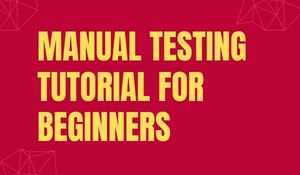
Overview of Manual Testing
Manual testing, as the term suggests, is a software testing process in which test cases are carried out manually without the usage of any automated tool. Manual software testing is by means of far the most primary of all testing methods, and in software applications, it supports the discovery of serious complications. It has to be first manually evaluated, right before the new applications can be automated. Testing takes extra time and effort, however, this is required to determine if automation is possible.
To conduct this, QAs comply with a written test plan that describes a set of unique test scenarios. The QA is required to analyze the overall performance of the web or mobile application from an end user’s perspective. QAs affirm the proper behavior of software applications towards anticipated behavior, and any difference is reported as a bug. Manual testing standards do no longer need acquaintance with any testing tool. There is a saying by the Software Testing Fundamentals that “100% Automation is not achievable,”
By taking a simple example to explain this process. To test an Application for its own functionality, A developer will create a website. In this case, to submit the credentials the expected behavior is by clicking the Login button and users will be able to enter their username and password. Although after submitting, the Login button doesn’t redirect the user to the home page when the test is executed. In cases like this, the QA will report a bug to the developer.
Manual testing is a vital part of any testing strategy as it helps QAs gain deeper insight from an end user’s perspective. Since manual testing without the intervention of testing automation frameworks, it has been carried out by a human and it judges software from the User Experience which is the most important metric. Consequently, Manual testing plays a vital role in exploratory testing or in test cases that are executed once or twice. In the early stages, this helps QAs to discover bugs in the development cycle.

Why we need manual testing
The foremost aim of manual testing is to guarantee that the program is error-free and that it encounters the defined required functionality. But whenever an application is unstable or has a bug or issues or creates a problem while end-users are using it. We need to perform one round of testing to make the application bug free and stable, where we do not want to come across these kinds of problems, and finally deliver a quality product to the client, because if the application is bug free, the end-user will use the application more conveniently. Test suites, also known as Test Cases, are created throughout the testing process. It also makes certain that identified faults are corrected by developers and the test engineer does manual testing, he/she can test the application from an end-user perspective and get more cordial with the product, which helps them to write the correct test cases of the application and give the quick feedback of the application and should provide 100% testing coverage. This testing ensures that the system is of top standard and that the consumer receives a bug-free product.
How to do Manual Testing?
Steps to do manual testing:
Step1: Initially, selecting the testing areas should review all the documents related to the software.
Step2: Study all the appropriate documents to get all the requirements mentioned by the end-user.
Step3: As per the requirement document intend to build test cases
Step4: By using white-box testing and black-box testing, we need to execute all the test cases manually.
Step5: If the bugs are detected, report them to the development team.
Step6: When the developer fixes the bug, Testers will retest it.
Roles and Responsibilities of a Manual Tester
The roles and responsibilities of a Manual Tester are:
- The client requirements will be put together and analyzed.
- Setting Up the test environment for executing the test cases.
- Analyzing and Running the test cases.
- Review Meetings will be put in order.
- To understand the product requirements, we will communicate with the users.
- Interacting with the Test Manager.
- Defect Tracking.
- Evaluating the testing results on bugs, errors, database impacts, and usability.
- Drawing up the reports on all the activities carried out while testing the software and reporting to design time.
Manual Testing Tools
In manual testing, we have distinct types of testing like unit, integration, security, performance, and bug tracking. Testing can be worked on various number of tools, where some of the tools are open-source, and some are commercial such as Jira, Bugzilla, Mantis, Zap, NUnit, Tessy, LoadRunner, Citrus, SonarQube, etc. accessible in the market.
Manual Testing Myths
The following are some of the well-liked testing misinterpretations and reality:
- Myth − Manual testing is perhaps done by anybody.
Fact − Testing necessitates a wide range of aptness.
- Myth − Manual testing is more effective than automated testing.
Fact − To pull off 100% test automation is not possible.
Note that manual software testing cannot be overemphasized.
- Myth − Testing is a very simple process.
Fact − Testing can be exceedingly tough. Good computational skills are required while testing an application for predictable use cases with few test cases.

Conclusion
Manual testing is a vital part of user-friendly software development. It requires different skill sets than software development. They need to think and act from an End User perspective. It is an activity where the tester needs to be very patient, creative & open-minded. The ability to empathize with the end-user, good communication, and documentation skills. According to some desired research, the average salary of a manual tester in the US is around $112K per annum. So, to build a good career in Software testing and if you wish to learn more about manual testing, you can sign up for the Manual Testing Training provided by Gologica and explore more areas of this field.
This Online Training Course is completely concentrated on the basics of manual testing. These days testing is playing a leading and very important role in the software industry because it decides based on your testing the quality of your software . Therefore, for people who want to become a software tester, this course is very important, and for people who are at the entry-level in this. Enroll in this Manual Online Training and make the best use of it. I hope this article guides you to enhance your manual testing skills.

